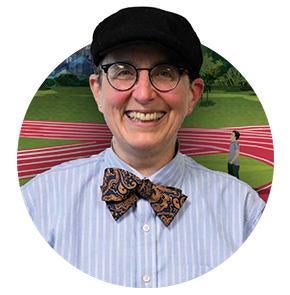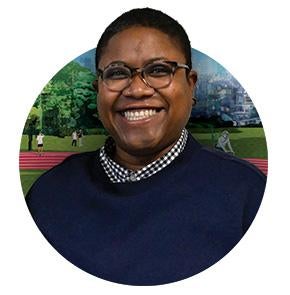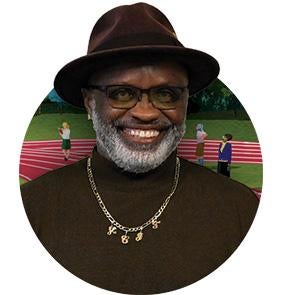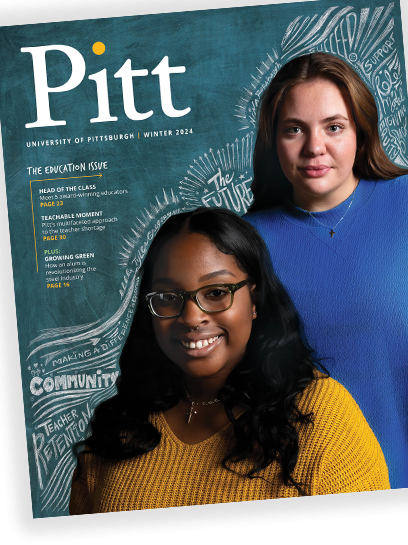
The social connections teens forge can be a buoy in the stormy waters of adolescence — but, sometimes, those relationships can cause more problems than they solve.
According to the Centers for Disease Control and Prevention, as many as one in 12 high school students in the United States have experienced dating violence, a form of intimate partner violence that can include physical and sexual assault and can occur in person and online. Victims of dating violence are more likely to be women, African Americans and those in the LGBTQ+ community.
At Pitt, Alana Fields, a research scientist in the Department of Pediatrics, is zeroing in on ways to prevent dating violence before it begins. She studies domestic violence against Black women, queer people and others and how emphasizing gender equity and mental health can improve a national anti-violence program that’s shown promising results: Coaching Boys Into Men (CBIM).
CBIM trains high school coaches to work with their young male athletes on healthy relationship and mental health practices that dispel the myth that aggression is a sign of strength. It works because it gives coaches the language and skills to share and shape attitudes and behavior through trusted relationships and socialization. Studies have shown that athletes involved in the program were significantly more likely to stop abusive behavior among their peers and less likely to perpetrate abuse themselves.
Fields (A&S ’20G) first began to study the implementation of CBIM in Pittsburgh-area schools while earning a PhD from Pitt’s Department of Sociology with support from its chair, Lisa Brush, a professor whose own research focuses on violence against women. Brush served as the committee chair for Fields’ dissertation and has rooted her on as she continues her research on the program.
Brush and Fields recently sat down with Richard Garland, an assistant professor in the School of Public Health and an expert on violence prevention among troubled youth. They discussed what mentor-led interventions like CBIM tell us about how to empower young people to be happier, healthier and better to each other.
This conversation has been edited for clarity and length.
Richard Garland: Coaches appear to be effective influencers when it comes to shaping young peoples’ behavior, even off the field. Why do you think that is?

Lisa Brush: They’re trusted adults. They’re often associated with prestige.
Alana Fields: That’s right. And we’re trying to connect youth with trusted adults as we implement new mental health practices. So, we’re thinking of people who work with student-athletes as mentors — folks who have a lot of face time with the athletes. The kids trust them, their parents trust them, the entire community trusts them. Also, structurally, it’s just built into how coaching works: the practicing, warming up, the drills. The antiviolence coaching becomes just a part of the routine, the culture of sports.
RG: How receptive are young people to the ideas CBIM coaches are trying to teach?
LB: Pretty receptive. One of the first big things I learned when I joined this project was that the kids are all right — but they can be hugely affected by what’s around them. It’s the connections between the coaches and the youth. It’s the connections between the athletes and their peers. It’s the connections between the coaches and the other people in the youth’s lives. We have to take the pressure off of these kids by surrounding them with support. That makes it possible for them to flourish using their own problem-solving skills.
RG: Why are antiviolence initiatives like these so important? What’s at stake?
AF: Everything. It’s about unlearning toxic masculinity and then relearning more gender equitable norms. And CBIM is unique because it’s an intergenerational model that not only touches the minds and actions of young people, but also the folks who are doing the implementation. And because of the culture of sport, the athletes are leaders in their schools and communities. So, if they learn more gender equitable attitudes and behaviors, it’s more likely that folks will listen to them.
LB: We know that just telling youth not to assault others or be a jerk isn’t the most effective way to make a difference. Athletes can become bellwethers, right? They become leaders for other social reasons. So, they are in a place and have the scaffolding of social support to start making changes in their peer groups. They’re talking with their peers and their near peers. This project is helping to cultivate those relationships, and that’s where the transformation can happen.

RG: Does self-esteem play a role in violence prevention? What kind of impact can it have?
AF: I think, honestly, there are certain sports where the self-esteem is just there — football, basketball and hockey. Most of these young athletes are already influencing behavior because most have the social capital and the self-esteem to have those conversations with other folks in their schools, in their communities. So, luckily, that influence is just built in.
LB: Self-esteem is a big part of it. But you can’t have community accountability if you don’t have community. Building community is an important step to having accountability. And community accountability is a key part of transformative justice. That’s why it is important to communicate — to them and to adults — that the youth matter and we care about what they have to say about the world that they live in.
RG: How are you measuring success when working with and researching CBIM?
LB: We’re looking for changes in people’s gender attitudes. We’re looking for changes in people’s self-reported behaviors. We’re looking at things that are specifically bystander interventions. We’re looking at people’s intentions to intervene when they’re in a bystander situation. Those are the big outcomes.
We’re also working on trying to develop relevant and intersectional tools for assessing gender equitable attitudes — that is, attitudes that position all genders equally. For example, what is different, or is it different, in Black communities compared to white communities? We’re also trying to think better about what it means to make transformation and community accountability happen.

RG: So, what can we take away from this work that we can apply to the larger goal of preventing violence among young people?
LB: That we need to connect kids with influencers who have the right kind of knowledge. We need to think of different ways to build community. That the ideas, the people, the measures, the science, the youth, the setting — they are part of a complicated system. But if you can make an impact somewhere within it, then you can see what kind of change can occur.
AF: We’ve got a beautiful model, and it’s very idealistic. But I think one of the big takeaways for me is that we need to be doing more training of folks in the community, collaborating with them. We need to help them prepare, right? Because folks in the community are who the young people will gravitate toward. We also need to make sure the tools are there for them to be able to do the work. Instead of only presenting a fixed curriculum, we need to work with the community to develop specifically what they need.
LB: Like I said, the kids are all right. We, as adults, just need to give them the positive support they deserve.



